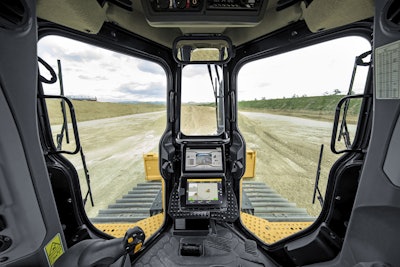
The dozer and its design defined Cat. They still call them “track-type tractors,” in keeping with the heritage. So when Cat comes out with a new model it’s like bringing a child into the world. Break out the cigars.
This latest edition to the family, the D5, inherits all the technological DNA of previous dozers plus a couple of new GPS-driven features in addition to more weight and horsepower. The goal is to make this dozer equally capable at heavy dozing and finish grading.
You can check out our full video interview and overview for the D5 just below or read on for all the details.
Let’s talk about the technology first.
The GPS system has been hidden out of sight, save for an antenna on the top of the cab, safe from damage and thieves. The machine and blade orientations are calculated by inertial measurement unit (IMU) sensors on the blade and the body of the machine.
It’s all built-in at the factory and referred to as Cat Grade with 3D. The operator interface on the monitor works like a smartphone with touchscreen style pinching and swiping functionality. Cat provides a separate monitor for GPS operations apart from the main 10-inch machine monitor in the center of the console.

The Stable Blade feature has been around a while but improved for the new D5.
“It’s a little more accurate and faster and significantly easier to use,” says Sam Meeker, product application specialist. It also uses blade positioning information from the IMUs to detect sudden or jerky movements of the blade. When it senses these, it sends instructions to the hydraulics to even out abrupt variations resulting in smooth, gradual transitions from one blade height to the next. This helps produce a smoother surface and eliminates washboarding, making—as the saying goes—good operators better and novice operators good.
These small efficiencies, over the course of a day also add up to improved productivity.
Slope Assist automatically maintains a blade slope setting when you don’t have a GPS signal or laser to guide you. It basically does the same thing as the old, gravity-based angle indicator gauges except you don’t have to eyeball the gauge on the back of the blade. With Slope Assist, your fore-aft tilt and side-to-side blade angle show up on a monitor in the cab. You can program the values you want on the screen and even let go of the joystick and the machine will continue on the slope parameters set on the screen.
The D5’s new technology features include Blade Load Monitor and Traction Control. These tap into information coming from an additional GPS sensor. The Blade Load Monitor detects sudden changes in speed and/or track slippage and shifts down to keep the load under power. In similar fashion the Traction Control temporarily reduces track power when slippage is detected so you can adjust the blade load to prevent productivity-robbing slippage.
The visual indications that guide the operator are gamified—you see a green/yellow/red bar and just keep it in the green for the optimal traction. “Every push in a dozer costs you something,” says Meeker. “You might as well make it the best push you can.”
Power and productivity

The D5 is going to replace the D6N in the family for now, but actually weighs 400 pounds more than the D6N in the XL package and 1,800 pounds extra in the low ground pressure (LGP) configuration. The engine bumped up 4 horsepower to 170 ponies.
The extra weight and power add up to a 4.5 percent increase in drawbar pull and 2.5 percent improvement in productivity, says Meeker.
Cat also put together a package of enhancements it calls “enhanced power train control” to drive additional efficiency in dozing operations with the D5. Hill Descent Control maintains your speed when cresting a hill and heading down without the need to jump on the service brake. And Hill Hold automatically engages the brakes to hold you in position while you’re in neutral. The Steering Radius Control uses sensors on the steering and the decel pedal to automatically downshift anytime you want to crank the dozer around in a tight turning radius.
Manual shifting has been eliminated on the D5. A fully automatic, 3-speed transmission shifts gears seamlessly allowing for smoother acceleration and faster cycle time.
The D5 is available in standard or low ground pressure (LGP) configurations with either a push arm/SU blade (semi-U shaped) or a variable pitch angle tilt (VPAT) blade. If you need to meet regional transport requirements, a folding VPAT blade is available. The new purpose-built push arm configuration for the SU blade puts the center of gravity a bit further forward for better cutting and penetration.
The cockpit

The old D5 had one of the smallest cabs in its class while the D6N had one of the largest. So Cat put a D6-sized cab on the new D5.
They also moved the exhaust stack to the side and integrated the A-pillar into the ROPS to improve visibility. A steeper slant over the hood also improves visibility to the blade. The seat is heated and ventilated and adjustable 13 ways. A high-def rearview camera brings up a panoramic view behind the dozer anytime you put it in reverse.
Safety conscious operators will also appreciate a “halo” grab bar that runs completely around the circumference of the cab—something to hang on to when cleaning the cab glass. A grab bar in the back gives you a steady hold when refueling as well.
What’s in a name?

As mentioned, the D5 will replace the D6N and reflects Caterpillar’s plan to make dozer model names simpler.
The D6K will become the D4, the D5K will become the D3, D4K will become the D2 and D3K will become the D1. Eventually the dozers will be known by just their size class, D5, D6, D11 and so forth. Cat started the nomenclature change process last year and should be fully transitioned by the end of next year.













